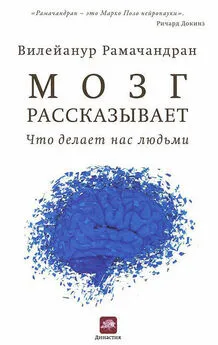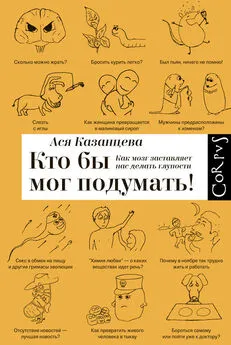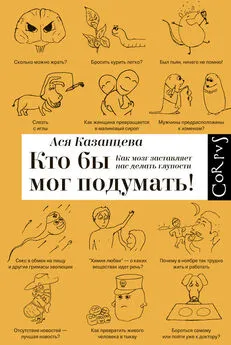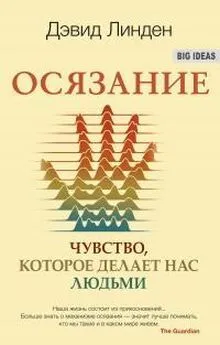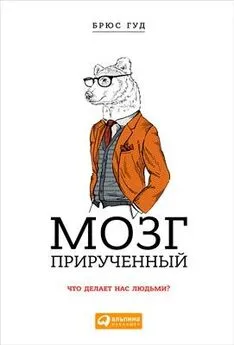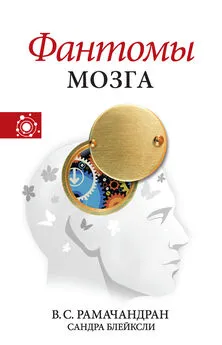Вилейанур Рамачандран - Мозг рассказывает. Что делает нас людьми
- Название:Мозг рассказывает. Что делает нас людьми
- Автор:
- Жанр:
- Издательство:Издательство «Карьера Пресс»
- Год:2012
- Город:Москва
- ISBN:978-5-904946-35-7
- Рейтинг:
- Избранное:Добавить в избранное
-
Отзывы:
-
Ваша оценка:
Вилейанур Рамачандран - Мозг рассказывает. Что делает нас людьми краткое содержание
Непостижимые загадки (как человек может хотеть ампутировать себе руку? почему рисунки аутичного ребенка превосходят по своему мастерству рисунки Леонардо? что такое чувство прекрасного? откуда берется в нас сострадание? как может человечество передавать культуру от поколения к поколению? что породило речь? где живет самосознание?) находят свое объяснение на уровне нейронов мозга — благодаря простым и гениальным экспериментам B. C. Рамачандрана. Он великий ученый современности, но у него еще и искрометное чувство юмора — и вот вам, пожалуйста, блестящее повествование о странном человеческом поведении и работе мозга.
Самые последние достижения науки о мозге. Где в мозге кроется то, что делает человека человеком? B. C. Рамачандран назван одним из ста самых выдающихся людей XX века.
Мозг рассказывает. Что делает нас людьми - читать онлайн бесплатно полную версию (весь текст целиком)
Интервал:
Закладка:
Di Pellegrino, G.Fadiga, L., Fogassi, L., Gallese, V., & Rizzolatti, G. (1992). Understanding motor events: A neurophysiological study. Experimental Brain Research, 91,176–180.
Domino, G. (1989). Synesthesia and creativity in fine arts students: An empirical look. Creativity Research Journal, 2,17–29.
‘Edelman, G. M. (1989). The remembered present: A biological theory of consciousness.New York: Basic Books.
‘Ehrlich, P. (2000). Human natures: Genes, cultures, and human prospect. Harmondsworth, UK: Penguin Books.
Eng, K.Siekierka, E., Pyk, P., Chevrier, E., Hauser, Y., Cameirao, М., et al. (2007). Interactive visuo-motor therapy system for stroke rehabilitation. Medical and Biological Engineering and Computing, 45,901–907.
‘Enoch, M. D., & Trethowan, W. H. (1991). Uncommon psychiatric syndromes (3rd ed.). Oxford: Butterworth-Heinemann.
‘Feinberg, Т. E. (2001). Altered egos: How the brain creates the self. Oxford University Press.
Fink, G. R., Marshall, J. C., Halligan, P. W., Frith, C. D., Driver, J., Frackowiak, R. S., et al. (1999). The neural consequences of conflict between intention and the senses. Brain, 122,497–512.
First, M. (2005). Desire for an amputation of a limb: Paraphilia, psychosis, or a new type of identity disorder. Psychological Medicine, 35,919–928.
Flor, H., Elbert, Т., Knecht, S., Wienbruch, C., Pantev, C.Birbaumer, N., et al. (1995). Phantom-limb pain as a perceptual correlate of cortical reorganization following arm amputation. Nature, 375,482–484.
Fogassi, L., Ferrari, P. F., Gesierich B., Rozzi, S., Chersi, F., & Rizzolatti, F. (2005, April 29). Parietal lobe: From action organization to intention understanding. Science, 308,662–667.
Friedmann, С. Т. Н., & Faguet, R. А. (1982). Extraordinary disorders of human behavior. New York: Plenum Press.
Frith, C. & Frith, U. (1999, November 26). Interacting minds-A biological basis. Science, 286, 1692–1695.
Frith, U., & Happe, F. (1999). Theory of mind and self consciousness: What is it like to be autistic? Mind and Language, 14,1-22.
Gallese, V., Fadiga, L., Fogassi, L., & Rizzolatti, G. (1996). Action recognition in the premotor cortex. Brain, 119, 593–609.
Gallese, V., & Goldman, A. (1998). Mirror neurons and the simulation theory of mindreading. Trends in Cognitive Sciences, 12,493–501.
Garry, М. I., Loftus, A., & Summers, J. J. (2005). Mirror, mirror on the wall: Viewing a mirror reflection of unilateral hand movements facilitates ipsilateral M1 excitability. Experimental Brain Research, 163,118–122.
‘Gawande, A. (2008, June, 30). Annals of medicine: The itch. New Yorker, pp. 58–64.
‘Gazzaniga, M. (1992). Nature’s mind. New York: Basic Books.
‘Glynn, I. (1999). An anatomy of thought. London: Weidenfeld & Nicolson.
‘Greenfield, S. (2000). The human brain: A guided tour. London: Weidenfeld & Nicolson.
‘Gregory, R. L. (1966). Eye and brain. London: Weidenfeld & Nicolson. Gregory, R. L.
(1992). Odd perceptions. New York: Routledge.
Grossenbacher, P. G., & Lovelace, С. T. (2001). Mechanisms of synesthesia: Cognitive and physiological constraints. Trends in Cognitive Sciences, 5(1), 36–41.
Happe, F., & Frith, U. (2006). The weak coherence account: Detail-focused cognitive style in autism spectrum disorders. Journal of Autism and Developmental Disorders, 36(1), 5-25.
Happe, F., & Ronald, A. (2008). The «fractionable autism triad»: A review of evidence from behavioural, genetic, cognitive and neural research. Neuropsychology Review, 18(4), 287–304.
Harris, A. J. (2000). Cortical origin of pathological pain. The Lancet, 355, 318–319.
Havas, H., SchifFman, G., & Bushnell, M. (1990). The effect of bacterial vaccine on tumors and immune response of ICR/Ha mice. Journal of Biological Response Modifiers, 9,194–204.
Hirstein, W., Iversen, P., Ramachandran, V. S. (2001). Autonomic responses of autistic children to people and objects. Proceedings of the Royal Society of London, Series B: Biological Sciences, 268(1479), 1883–1888.
Hirstein, W., & Ramachandran, V. S. (1997). Capgras syndrome: A novel probe for understanding the neural representation and familiarity of persons. Proceedings of the Royal Society of London, Series B: Biological Sciences, 264(1380), 437–444.
Holmes, N. P., & Spence, C. (2005). Visual bias of unseen hand position with a mirror: Spatial and temporal factors. Experimental Brain Research, 166,489–497.
Hubbard, E. М., Arman, A. C., Ramachandran, V. S., & Boynton, G. (2005). Individual differences among grapheme-color synesthetes: Brain-behavior correlations. Neuron, 45(6), 975–985.
Hubbard, E. М., Manohar, S., & Ramachandran, V. S. (2006). Contrast affects the strength of synesthetic colors. Cortex, 42(2), 184–194.
Hubbard, Е. М., & Ramachandran, V. S.(2005). Neurocognitive mechanisms of synesthesia. Neuron, 48(3), 509–520.
«Hubei, D. (1988). Eye, brain, and vision. Scientific American Library Series. New York: W. H. Freeman.
Humphrey, N. (1992). A history of the mind. New York: Simon & Schuster. Humphrey, N. K. (1980). Nature s psychologists. InB. D. Josephson & V. S. Ramachandran (Eds.), Consciousness and the physical world: Edited proceedings of an interdisciplinary symposium on consciousness held at the University of Cambridge in January 1978. Oxford, UK/New York: Pergamon Press.
‘Humphreys, G. W., & Riddoch, M. J. (1998). To see but not to see: A case study of visual agnosia. Hove, East Sussex, UK: Psychology Press.
’Iacoboni, M. (2008). Mirroring people: The new science of how we connect with others. New York: Farrar, Straus.
Iacoboni, М., & Dapretto, M. (2006, December). The mirror neuron system and the consequences of its dysfunction. Nature Reviews Neuroscience, 7(12), 942–951.
Iacoboni, М., Molnar-Szakacs, I., Gallese, V., Buccino, G., Mazziotta, J. C., & Rizzolatti, G. (2005). Grasping the intentions of others with one’s own mirror neuron system. PLoS Biology, 3(3). e79.
Iacoboni, М., Woods, R. P., Brass, М., Bekkering, H., Mazziotta, J. C., & Rizzolatti, G. (1999, December 24). Cortical mechanisms of human imitation. Science, 286, 2526–2528.
Jellema, Т., Oram, M. W.Baker, С. I., & Perrett, D. I. (2002). Cell populations in the banks of the superior temporal sulcus of the macaque monkey and imitation. In a. N. Melzoff & W. Prinz (Eds.), The imitative mind: Development, evolution, and brain bases (pp. 267–290). Cambridge, UK: Cambridge University Press.
Johansson, G. (1975). Visual motion perception. Scientific American, 236(6), 76–88.
‘Kandel, E. (2005). Psychiatry, psychoanalysis, and the new biology of the mind. Washington, DC: American Psychiatric Publishing.
‘Kandel, E. R., Schwartz, J. H., & Jessell, Т. M. (Eds.). (1991). Principles of neural science (3rd ed.). Norwalk, CT: Appleton & Lange.
Kanwisher, N., & Yovel, G. (2006). The fusiform face area: A cortical region specialized for the perception of faces. Philosophical Transactions of the Royal Society of London, Series B: Biological Sciences, 361, 2109–2128.
Karmarkar, A., & Lieberman, I. (2006). Mirror box therapy for complex regional pain syndrome. Anaesthesia, 61,412–413.
Keysers, C., & Gazzola, V. (2009). Expanding the mirror: Vicarious activity for actions, emotions, and sensations. Current Opinion in Neurobiology, 19, 666671.
Keysers, C., Wicker, B.Gazzola, V., Anton, J. L., Fogassi, L., & Gallese, V. (2004). A touching sight: SII/PV activation during the observation and experience of touch. Neuron, 42,335–346.
Kim, C.-Y., Blake, R., & Palmeri, T. J. (2006). Perceptual interaction between real and synesthetic colors. Cortex, 42,195–203.
‘Kinsbourne, M. (1982). Hemispheric specialization. American Psychologist, Ъ1, 222231.
Kolmel, К. F., Vehmeyer, К., & Gohring, E., et al. (1991). Treatment of advanced malignant melanoma by a pyrogenic bacterial lysate: A pilot study. Onkologie, 14, 411–417.
Kosslyn, S. М., Reiser, B. J., Farah, M. J., &c Fliegel, S. L. (1983). Generating visual images: Units and relations. Journal of Experimental Psychology, General, 112, 278–303.
Lakoff, G., & Johnson, M. (2003). Metaphors we live by. Chicago: University of Chicago Press.
Landis, Т., & Thut, G. (2005). Linking out-of-body experience and self processing to mental own-body imagery at the temporoparietal junction. The Journal of Neuroscience, 25, 550–557.
“LeDoux, J. (2002). Synaptic self. How our brains become who we are. New York: Viking Press.
*Luria, A. (1968). The mind of a mnemonist. Cambridge, MA: Harvard University Press.
MacLachlan, М., McDonald, D., & Waloch, J. (2004). Mirror treatment of lower limb phantom pain: A case study. Disability and Rehabilitation, 26, 901904.
Matsuo, A., Tezuka, Y., Morioka, S., Hiyamiza, М., & Seki, M. (2008). Mirror therapy accelerates recovery of upper limb movement after stroke: A randomized crossover trial [Abstract]. Paper presented at the 6th World Stroke Conference, Vienna, Austria.
Mattingley, J. B., Rich, A. N., Yelland, G., & Bradshaw, J. L. (2001). Unconscious priming eliminates automatic binding of colour and alphanumeric form in synaesthesia. Nature, 401(6828), 580–582.
McCabe, C. S., Haigh, R. C., Halligan, P. W., & Blake, D. R. (2005). Simulating sensorymotor incongruence in healthy volunteers: Implications for a cortical model of pain. Rheumatology (Oxford), 44, 509–516.
McCabe, C. S., Haigh, R. C.Ring, E. F.Halligan, P. W., Wall, P. D”& Blake, D. R. (2003). A controlled pilot study of the utility of mirror visual feedback in the treatment of complex regional pain syndrome (type 1). Rheumatology (Oxford), 42,97-101.
McGeoch, P., Brang, D., & Ramachandran, V. S. (2007). Apraxia, metaphor and mirror neurons. Medical Hypotheses, 69(6), 1165–1168.
’Melzack, R. A., & Wall, P. D. (1965, November 19). Pain mechanisms: A new theory. Science, 150(3699), 971–979.
Merzenich, М. М., Kaas, J. H., Wall, J., Nelson, R. J., Sur, М., & Felleman, D. (1983). Topographic reorganization of somatosensory cortical areas 3b and 1 in adult monkeys following restricted deafferentation. Neuroscience, 8, 33–55.
Читать дальшеИнтервал:
Закладка:
